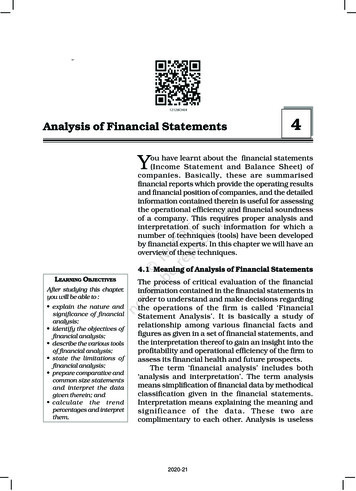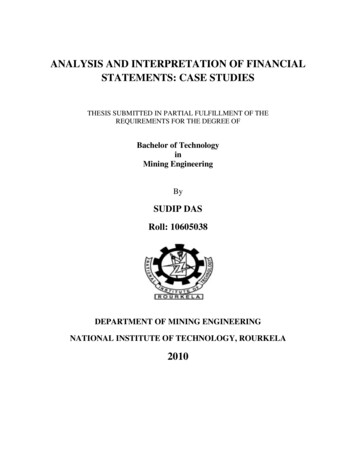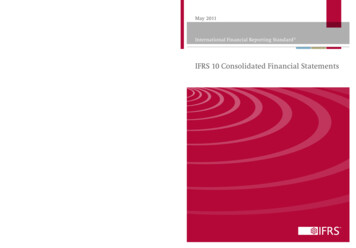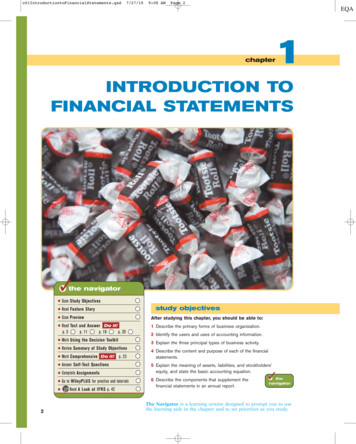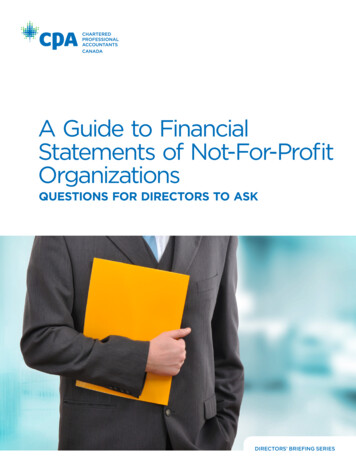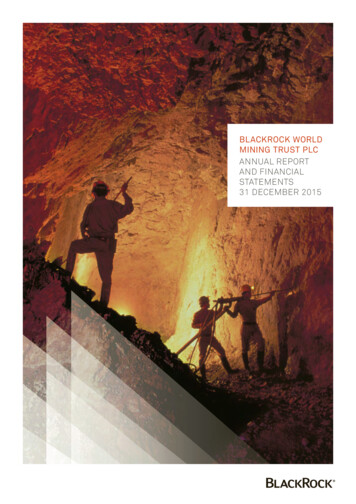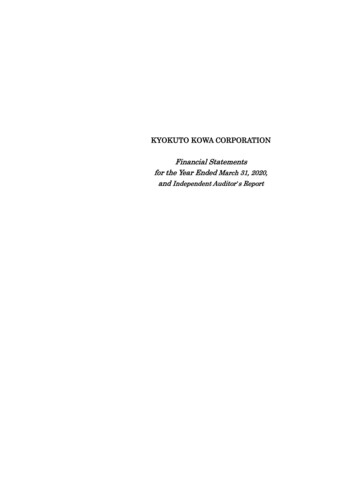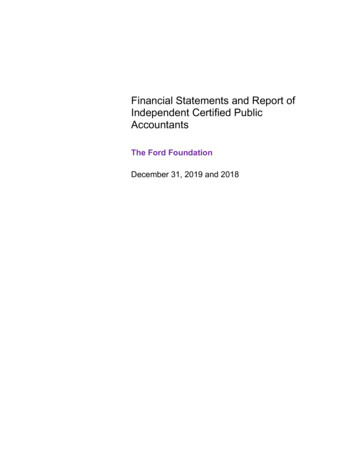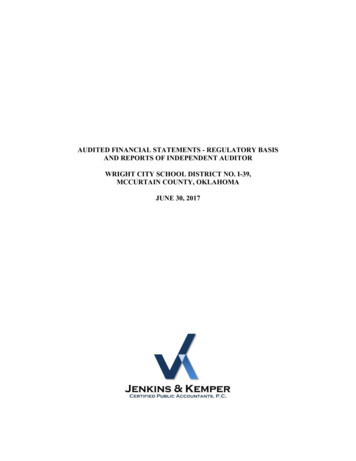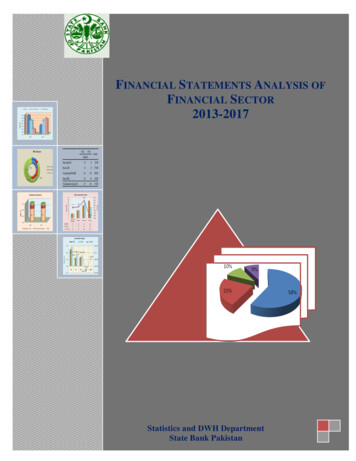
Transcription
Financial Statements Analysis of Financial Sector2017FINANCIAL STATEMENTS ANALYSIS OFFINANCIAL SECTOR2013-2017CY06CY07GrowthBil ion Rs.Share Capital (SC)9.5Reserves (RS)5.412 26.30%15 177.80%Un Appropriated Profit (RE)15.640.7 160.90%Others (MISC)0.80.4 -50.00%Total Shareholders’ Equity (SE)31.368.1 117.60%Statistics and DWH DepartmentState Bank Pakistan
Financial Statements Analysis of Financial Sector2017Vision and Mission Statements of State Bank of PakistanVisionTo be an independent credible central bankthat achieves monetary and financial stabilityand inclusive financial sector developmentfor the long-term benefit of the people ofPakistan.MissionTo promote monetary and financial stabilityand foster a sound and dynamic financialsystem, so as to achieve sustained andequitable economic growth and prosperityin Pakistan.
Financial Statements Analysis of Financial Sector2017Team Leader Muhammad Jaweed AkhtarSr. Joint Directormuhammad.jaweed@sbp.org.pkTeam Members Faisal AltafDeputy Directorfaisal.altaf@sbp.org.pk Uzma MaqsoodDeputy Directoruzma.maqsood@sbp.org.pk Bushra IqbalAssistant Directorbushra.iqbal@sbp.org.pk
Financial Statements Analysis of Financial Sector2017CONTENTSPreface .vExecutive Summary .viIntroduction. .11.1 Methodology .21.2 Concepts and Definitions .31.3 Performance Indicators .14Review and Financial Analysis of:Banks .25Development Finance Institutions (DFIs) .69Microfinance Banks (MFBs) . 80Leasing Companies .94Investment Banks .106Mutual Funds (Close Ended) . .116Modaraba Companies . 124Exchange Companies . .149Insurance Companies . 178Housing Finance .234Venture Capital . .237Appendix .242Explanatory Notes .246
Financial Statements Analysis of Financial Sector2017PrefaceThe financial sector, one of the most important components of the country’s economy essentially requires asound, stable and robust financial system for economic well being of the country and its populace.Pakistan’s financial sector represents a well-developed integration of institutions of a diversifiednature including Banks, DFIs, Microfinance Banks, Investment Banks, Leasing Companies, ModarabaCompanies, Housing Finance, Mutual Funds, Insurance Companies, Exchange Companies andVenture Capital. Disclosure and transparency in information on business activities of financialinstitutions are therefore of immense importance to all stakeholders.An overview of business and financial conditions of financial institutions is presented in a structuredmanner in form of financial statements. For large financial institutions, the financial statements areoften complex and are prepared under international accounting standards. These statements usuallyinclude an extensive set of notes to the financial statements. The notes typically describe each item onthe balance sheet, income statement, cash flow statement and statement of profit and loss accounts infurther detail.The stakeholders and users, on the other hand, require financial indicators that can provide informationon how well the company is performing and what may happen in future. In order to meet the growingneeds of the users, Statistics & Data Warehouse Department carries out analysis of the financial statements ofall financial institutions on annual basis. Every endeavour is made to select useful and accurate data fromfinancial statements and compute ratios that can provide valuable clues about the financial health ofthese institutions. The analysis is published in form of this publication namely “Financial StatementsAnalysis of Financial Sector”. The publication covers analysis of financial statements of financial institutionsfor the period 2013-17.It is hoped that the publication will provide a tool to researchers, policy makers and investors to understandthe activities and performance of financial sector in Pakistan. Comments on the analysis and suggestions forfurther improvements of the publication are very welcome.(Dr Azizullah Khattak)DirectorStatistics & DWH Departmentv
Financial Statements Analysis of Financial Sector2017Executive SummaryFinancial statements analysis of 168 companies from 11 sectors namely, Banks, Development FinanceInstitutions (DFIs), Microfinance Banks (MFBs), Leasing companies, Investment Banks, Mutual Funds,Modarabas, Exchange companies, Insurance companies, Housing Finance and venture capital are includedin this publication for the period 2013-17.Banking sector comprises local banks and foreign banks. Local banks include private sector banks, publicsector banks and specialized banks. The balance sheet size of the banking sector expanded in CY17. Totalassets of the banking sector grew from Rs. 15.99 trillion in CY16 to Rs. 18.53 trillion in CY17 showing anincrease of 15.91 percent. Total liabilities and equity (including others) witnessed increases of 17.16percent and 2.89 percent respectively during the year. Growth of the banking sector was mainly attributedto significant increase of 15.25 percent in the balance sheet size of local banks. Foreign banks comprising3.00 percent share in banking sector recorded an increase of 42.31 percent during CY17. Profit before andafter tax of banking sector as a whole decreased by Rs. 59.22 billion or 18.55 percent and Rs. 38.32 billionor 19.83 percent respectively during the CY17 over CY16.DFIs exhibited an expansion in their balance sheet size during the period under review. Total assetsincreased by 10.47 percent to reach Rs. 207.10 billion in CY17 from Rs. 187.48 billion in CY16. Totalliabilities increased by 19.24 percent or Rs. 19.85 billion in FY17 over FY16 whereas, total shareholders’equity (including others) posted a slightly decline of 0.27 percent in CY17 when compared with CY16. Asignificant decrease in profit before tax and profit after tax is observed in CY17 over CY16. During theyear profit before tax decreased by 38.33 percent with an amount of Rs. 3.91 billion and profit after taxdeclined by 43.03 percent or Rs. 3.27 billion over the previous year.Microfinance sector continued its positive stride with total assets increased by 45.27 percent to reach Rs.247.16 billion in CY17 from Rs. 170.13 billion in CY16. Total liabilities and total equity (including others)increased by Rs. 69.13 billion or 47.47 percent and Rs. 7.89 billion or 32.20 percent respectively in CY17over CY16. Profits before and after taxation increased by 60.89 percent and 66.41 percent respectivelyduring the year.Asset based of Leasing Sector increased by 0.33 percent over the year from Rs. 46.29 billion in FY16 toRs. 46.45 billion in FY17. The sector showed profit before taxation of Rs. 1131.47 million in FY17 ascompared to Rs. 897.80 million in FY16. Profit after taxation was recorded Rs. 774.51 million in FY17 ascompared to Rs. 665.17 million in FY16, showing a YoY growth of 16.44 percent in FY17.The performance of investment banks deteriorated slightly during the year. Analysis reveals that theirbalance sheet size drop by 13.41 percent in FY17 as compared to FY16. Total shareholders’ equity(including others) decreased by 9.44 percent over the previous year. One of the main reason behind thisdecline is that one investment bank with shareholder’s equity of Rs. 207 million in FY16 has been droppedvii
Financial Statements Analysis of Financial Sector2017from the analysis in FY17 due to its change in nature of business from investment bank to assetmanagement company. Similarly, a decrease of 15.71 percent is observed in total liabilities during FY17.Profit before tax dropped from Rs. 0.06 billion in FY16 to Rs. 0.05 billion in FY17.Balance sheet size of Mutual Funds (close ended) expanded by Rs. 2.83 billion, showing an YoY increaseof 13.75 percent in total assets during FY17 over FY16. Total assets increased from Rs. 20.61 billion inFY16 to Rs. 23.44 billion in FY17. Total equity (including others) increased by 14.97 percent during FY17when compared to FY16. Total liabilities of Mutual Funds decreased by 17.55 percent in FY17 ascompared to FY16. Gross income also reached at Rs. 4.04 billion in FY17 from Rs. 1.49 billion in FY16.Balance sheet size of modaraba companies expended during FY17. Total assets, liabilities and equityincreased during FY17 when compared to FY16. Total assets increased from Rs. 36.84 billion in FY16 toRs. 44.02 billion in FY17 showing an increase of 19.49 percent over FY16. Total equity witnessed a YoYincrease of 6.08 percent in FY17. Total liabilities of Modaraba companies also increased by 35.30 percentin FY17 when compared with the FY16. Profit before and after tax tax increased by 32.56 percent and33.02 percent respectively in FY17 over FY16.Exchange Companies continued its upward stride in its balance sheet size. Total assets increased by 11.08percent to stand at Rs. 13.53 billion in CY17 as compared to Rs. 12.18 billion in CY16. Exchangecompanies, mainly dealing with transfer of funds, cash and balances with banks have kept around 61.13percent share of its total assets in CY17. Similarly, total equity increased to Rs. 11.31 billion in CY17 fromRs. 10.15 billion in CY16, recording YoY increase of 11.34 percent. Profit before and after taxation,recorded increases of 16.42 percent and 18.66 percent respectively in CY17 over CY16.The balance sheet size of insurance sector expanded by 11.70 percent, with corresponding increases of13.53 percent in total liabilities during CY17. The growth of Insurance sector was mainly attributed tosignificant increase of 13.74 percent in the size of balance sheet of life insurance. Takaful companiesshared 1.97 percent of insurance sector in CY17, recorded YoY increase of 15.40 percent during CY17 intheir assets.Housing Finance Sector showed a decline of 2.77 percent in total assets which decreased from Rs. 20.91billion in CY16 to Rs. 20.33 billion in CY17. However, total equity (including others) showed a YoYincrease of 4.96 in CY17 over CY16. A significant increase of 340.93 percent and 287.09 percent wasrecorded in profit before tax and profit after tax respectively during CY17 as compared with CY16.Balance sheet size of Venture Capital expended by Rs. 7.09 million or 18.09 percent during FY17. Totalassets of Venture Capital increased by 18.09 percent from Rs. 39.17 million in FY16 to Rs. 46.26 million inFY17. Total liabilities increased from Rs. 4.82 million in FY16 to Rs. 5.23 million in FY17, showing anincrease of 8.33 percent. Total equity (including others) recorded a YoY growth of 19.46 percent in FY17over the previous year.vii
Financial Statements Analysis of Financial Sector2017IntroductionStatistics and Data Warehouse Department strives hard to disseminate quality statistics. It not onlyproduces primary data but also provides secondary data with analysis to the various stakeholdersincluding researchers and policy makers. As the performance of financial sector reflects the financialhealth of an economy, standard analytical tools are used to gauge the performance of this vital sector.The analysis1 includes the following sectors2: BanksDFIsMicrofinance BanksInvestment BanksLeasing CompaniesModaraba CompaniesInsurance CompaniesExchange CompaniesMutual Funds (close ended)Housing FinanceVenture CapitalConsolidation is provided at the beginning of each sector’s analysis. For banks, consolidation is atdifferent levels. At first level, overall consolidation of all banks including foreign banks is given. Theinformation and ratios relating to number of ordinary shares, dividend earning per share and breakupvalue per share are not taken into consideration because foreign banks do not have such type ofinformation. The level of consolidation for banks is as follows: All Banks (overall) Local Banks- Public Sector BanksPrivate Sector BanksSpecialized BanksForeign BanksSimilarly, consolidated analysis of insurance companies is also provided to reflect financial health ofInsurance Sector. The level of consolidation is as follows: Insurance Companies (overall)1Since each sector has peculiar business activities, therefore, for analysis separate set of variables was taken into consideration. Similarly, anassociated set of financial ratios has also been selected for each sector.2Sector-wise list of analyzed financial institutions is provided in “appendix” at the end of the text.1
Financial Statements Analysis of Financial Sector Life Insurance Non-Life Insurance Takaful20171.1 MethodologyMethodology used for analysis is ratio analysis because it is a powerful tool to analyze financialstatements of any company. Ratio analysis measures inter-relationship between various items of thefinancial statements. Ratios are taken as guide lines for these are useful in evaluating a company’sfinancial position and operation and making comparison with results in previous years or with othersin the same industry. The primary objective of ratio analysis is to point out areas requiring furtherinvestigation. Ratios are calculated from the following financial statements and relevant notes toaccounts. Balance Sheet Profit and Loss Account Statement of Changes in Equity Cash Flow StatementTotal equity is computed as the sum of ordinary share capital plus reserve & surplus plus unappropriated profit/loss while the revaluation, intangible assets etc. are clubbed together in ‘others’ oftotal equity section. For foreign banks, the ordinary share capital is replaced by head office capitalaccount. Since the financial sector comprises variety of financial institutions having peculiar businessactivities, therefore, variables used for analysis would be different for each sector.2
Financial Statements Analysis of Financial Sector20171.2 Concepts and DefinitionsBanks, Development Finance Institutions (DFIs) and Microfinance Banks (MFBs)Following variables are used for analysis of banks, DFIs and MFBs:Shareholders’ EquityThe sum of following items except “others” is considered for analysis: Ordinary Share Capital or Head Office Account (in case of foreign bank) Reserves Un-appropriated Profit/Loss OthersLiabilitiesBills Payables, borrowings and deposits being the major items contributing towardsliabilities of banks, DFIs and MFBs are taken for analysis, the remaining heads of liabilitiesare pooled under ‘others’: Bills Payables Borrowing from Financial Institutions Deposits and Other Accounts OthersAssetsThe following items are included in the analysis. The relevant information is taken frombalance sheet as well as respective notes to accounts. Cash and Balances with Treasury BanksBalances with Other BanksLending to Financial InstitutionsInvestment Gross Advances Advances –Non-Performing/ClassifiedProvision Against AdvancesAdvances Net of ProvisionFixed Assets OthersProfit and Loss AccountThe following items are included for analysis. The relevant figures are obtained from profitand loss accounts and notes to financial statements. Interest Earned Interest Expensed 3Non-Interest IncomeNon-Interest Expense
Financial Statements Analysis of Financial Sector Net Interest Income Provision and Write-offs Net Interest Income after Provision 2017Administrative ExpensesProfit/Loss before TaxProfit/Loss after TaxOther Items No. of Ordinary SharesOutstanding shares at end of the period as shown in balance sheet. Cash DividendThe amount of cash dividend is taken as the percentage declared during theperiod. Stock Dividend/Bonus SharesThe number of bonus shares declared is also taken as percentage amountdistributed during the period. Cash Generated from Operating ActivitiesThe amount is taken from cash flow statement Commitment and ContingenciesThis is an off balance sheet item. The detail is given in notes to accounts andthe sum of all kinds of commitments and contingencies is taken for analysis.Leasing CompaniesFollowing variables are involved in the analysis of leasing companies:Shareholders’ EquityShareholders’ equity includes share capital, reserves and un-appropriated profit/loss. Anyother item(s) mentioned in the balance sheet under shareholders’ equity is pooled under thehead ‘others’.LiabilitiesBorrowings from financial institutions and deposits with financial institutions are the majoritems contributing towards liabilities of leasing companies. For analysis, these two items aretaken separately while the remaining items of liabilities are pooled under ‘others’4
Financial Statements Analysis of Financial Sector2017AssetsAssets are classified into current and non-current. Major items of non-current assets arementioned below where remaining items of non-current assets are pooled under “others”Non-Current Assets Term Deposit Certificates Net Finance-Investment Advances – Net Fixed Assets OthersCurrent AssetsThree main items are taken for analysis while the rest are pooled under ‘others’ Cash and Balances with Central Bank Balances with Other Banks Placement with Other Banks OthersProfit and Loss AccountThe amounts reported under the following heads are extracted from profit and loss accountsalong with relevant notes to accounts: Income from Operating Lease Administrative Expenses Income from Investment Profit/Loss before Tax Income from Finances Profit/Loss after Tax Other IncomeOther Items No. of Ordinary SharesThe number of shares outstanding as on balance sheet date Cash DividendThe amount of cash dividend is taken as percentage of the dividend declared duringthe period.5
Financial Statements Analysis of Financial Sector 2017Stock DividendThe number of bonus shares declared is also taken as percentage amount during theperiod. Cash Generated from Operating ActivitiesThe amount is taken from the cash flow statement.Investment BanksFollowing variables are used in the analysis of investment banks:Shareholders’ EquityThe composition and explanation of shareholders’ equity is same as explained earlier.LiabilitiesThe amount of current and non-current liabilities is taken from the balance sheet and thesum of these two is the same as total liabilities of the company.AssetsCurrent assets are classified into ‘cash and bank balances’ and ‘others’ while non-currentassets are divided into three heads i.e., long term investment, fixed assets, and others.Current AssetsNon-Current Assets Cash and Banks Balances Long Term Investment Others Fixed Assets OthersProfit and Loss AccountThe following items are taken for analysis. The relevant figures are taken from profitand loss account and notes to financial statements. Gross Revenues Administrative and Operating Expenses Operating Profit Profit/Loss before Tax Profit/Loss after Tax6
Financial Statements Analysis of Financial Sector2017Other ItemsThese include: No. of Ordinary Shares Cash Dividend Stock Dividend Cash Generated from Operating ActivitiesMutual Funds (Close Ended)The analysis includes the following variables:Shareholders’ EquityThe composition and explanation of shareholders’ equity is same as explained earlier.LiabilitiesAs the financial activities of mutual funds are limited, the composition of liabilities is dividedinto two heads as follows: Payable to Investment Adviser OthersAssetsThe asset base of mutual fund is also not broad, therefore, for analysis it is limited to threeitems. These are available in the company’s balance sheet and notes to financial statements. Cash and Banks Balances Investmen
Financial Statements Analysis of Financial Sector 2017 vii from the analysis in FY17 due to its change in nature of business from investment bank to asset management company. Similarly, a decrease of 15
